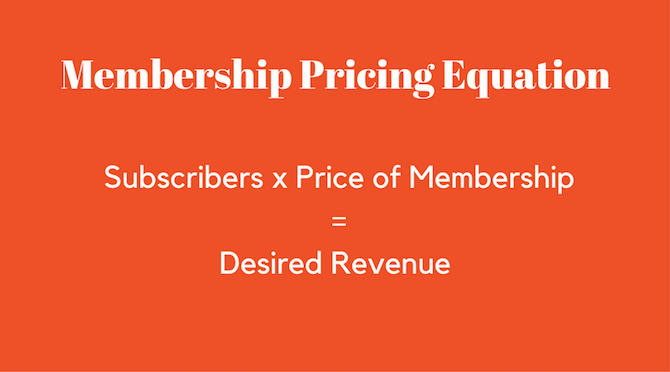
Membership site handbook
A practical guide to building a successful subscription business.
Chapter Two: Pricing
Now that you've done your preliminary research and planning, it's time to focus on one of the most important aspects of your membership offering. Figuring out how to price your memberships is relatively simple. Here are a few strategies you can implement to price your services accurately.
Don’t charge too little
Charging too little for your services may sound like a smart way to start, but it often backfires, and your services end up perceived as less valuable. Plus, it will be a lot more challenging to hit your revenue goals. Memberships are a multiplication problem (more on this later), and incremental increases in pricing make a big difference.
Annual or monthly subscriptions?
When you’re trying to decide on the type of plan you'd like to offer (monthly, yearly, etc.) the most important factor to consider is what each offering means as far as revenue. According to Brian Krogsgard, yearly is the way to go. He shared, “I personally like having yearly memberships. A friend taught me the concept of incremental regret with monthly memberships, where someone sees your charge right next to stuff they use and love (Netflix, etc.), and if they aren’t actively using your service, they regret that month of membership. A yearly model is a harder sell, because it’s more expensive upfront, but I like the way the customer can look back on the previous year, and consider collectively whether they got value from the service enough to renew another year. It’s less sensitive to customers not taking full advantage of your membership offering one or two months.”
Monthly billing may be appealing to your audience because of the lower fee, but a yearly option will usually perform better. For starters, you’ll get the money up front and that cash flow comes with a guaranteed 12 months of customer retention. There’s also a lower churn rate associated with yearly memberships, likely due to the “incremental regret” concept Krogsgard mentioned. Plus, you’ll have 365 days to prove the real value of your offering to customers instead of a short 31 days or less where your audience may not receive the full benefits of your membership and decide not to renew.
Start with simple pricing
We recommend two plans to get started. For example, $9 per month and $99 per year. This encourages new subscribers to choose your annual option (which you prefer) by offering annual subscribers a discount off the monthly rate. Another even simpler idea is to just offer an annual option. So, starting with one or two simple plans is best, but how you price those plans really depends on your audience.
Audience based pricing
Catering to professionals? Price higher and try to gauge what they would pay in the real world for something of similar value. Catering to consumers? Consider starting with a lower price point while also considering what they would pay in the real world. For example, one of our customers, a well-known chef, charges anywhere from $750 to $2,000 for in-person training. People from all around the world are willing to pay the fee to attend his classes and companies like Facebook are happy to fly him out to train their in-house chefs. So, it’s a no-brainer for him to set his online pricing to $499 a year and frame it against what he charges for in-person training. When you look at it that way, $499 a year is a great value.
Worried your prices are too high?
It’s natural to underestimate what your worth. But it’s always better to increase the value of what you're selling to meet your price, then decrease your rate to match your value. As we mentioned, keep it simple, and remember that dropping your prices lower will make it extremely hard to build a sustainable business without massive scale.
Work backwards
Start with the end in mind. How much money do you want to make? How much revenue do you need for your membership business to be sustainable? Let’s say your revenue goal is $100,000; you can use the following equation: the total number of subscribers multiplied by the desired price of your membership equals desired yearly revenue. If you want $100,000 in yearly revenue, you would need to charge $9 a month or $99 a year to at least 1,000 subscribers.

Know your audience
What does your target audience look like? Who are you selling to? Are you selling to businesses that can write off your courses, podcast, and email subscriptions as an expense or are you selling to individuals who may have less disposable income? A great example of someone understanding the ins and outs of selling to your audience is subscription-based technology and media newsletter, Stratechery, written and managed by Ben Thompson. His audience is made up of investors, venture capitalist, and tech industry professionals that generally have more to spend on memberships, and his pricing and messaging fits that audience.
Another customer, Sue Bryce Education, also charges three times the bare minimum we suggest because she's targeting photography professionals. You’ll want to consider who your audience is and what they are willing to pay, not only when it comes to pricing, but also when it comes to building your audience.
Focus on the long term
You don’t need thousands of members to run a successful membership website. As Jesse Perry of successful membership site, Team Flower shared with us, “It can be intimidating for someone to start out thinking that they need to get 10,000 email subscribers overnight; it’s more important to have 100 people who care. You can be as profitable off of 100 people than you can be from 10,000 disengaged people.” Your focus should be generating positive, long-term, ROI — whether you’re starting with 120 members or just 12.
Now that you've set your pricing and have completed your research and planning, it's time to get your tools together!
Next up, Building